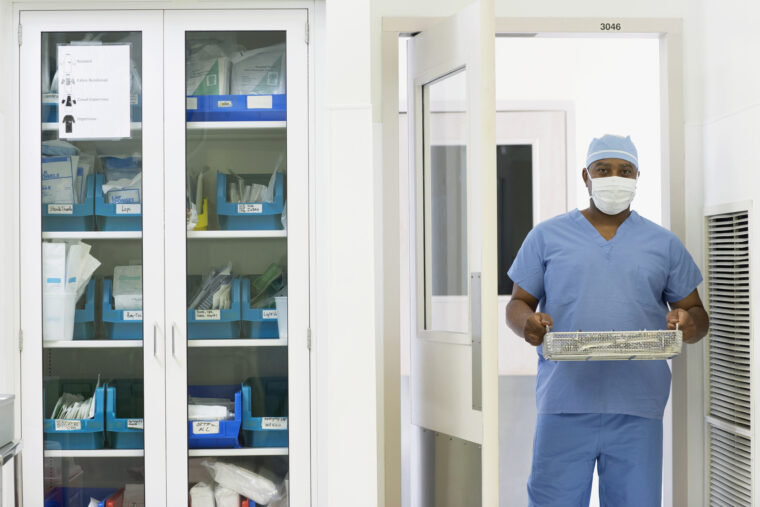 Delivering high-quality healthcare depends on having tools and supplies available and ready to use when they are needed. But to provide access to the right supplies at the right moment, healthcare organizations must have those supplies stored properly with the right amount of inventory to avoid both waste and scarcity.
Delivering high-quality healthcare depends on having tools and supplies available and ready to use when they are needed. But to provide access to the right supplies at the right moment, healthcare organizations must have those supplies stored properly with the right amount of inventory to avoid both waste and scarcity.
By optimizing their storage space, hospital leaders can effectively tackle the ongoing challenges of inventory and supply management, ensuring that their clinicians will always have access to the supplies they need to provide safe, efficient care. An important key to creating optimized storage spaces is choosing and using the right storage solutions.
High-Density Shelving
Rather than relying on the traditional shelves and cabinets that may have been installed in your facility years ago, optimize your storage with high-density shelving. These systems are available in manual, mechanical-assist and electrically operated styles, depending on the type and weight of supplies to be stored.
“High-density solutions can more than double your storage capacity or free up space for other uses,” says Catherine Adkins, project manager at Storage Systems Unlimited. “These systems maximize space utilization by eliminating aisles and compacting several storage cabinets or shelving systems into a much smaller amount of space. An aisle or access to your supplies is opened only when and where you need it by easily shifting entire rows of shelving.”
This type of shelving has become increasingly popular for optimizing storage space in all sorts of commercial buildings. Storage Systems Unlimited installs high-density storage solutions in hospitals as well as golf courses, college athletic departments, attorney offices and prisons.
Hanging Wire Baskets
Another powerful product for optimizing hospital storage space is the wall mount louvered panel, which can hold wire baskets. These panels with hanging wire baskets can drastically increase capacity and efficiency in supply rooms.
“By using the wire baskets, you eliminate most of the dust that can collect in plastic bins,” Adkins says. “The wire baskets allow for better line of sight for the nurses and supply chain staff when locating certain supplies.”
Many healthcare facilities use wire shelving, but that can create too much wasted space and lead to wasted resources. Supplies often fall behind the wire shelving and are not found until they have expired. Hanging wire baskets, on the other hand, reduce wasted space all around. The supplies cannot fall behind the louvered panels, so inventory control is much easier. Also, the baskets are available with modular dividers as well as label holders of various types and colors, all of which can help staffers keep supplies organized and readily seen.
Carts of All Types
Aside from shelving and cabinetry, carts are an important product for optimizing storage—and there is a wide variety of carts that can help hospitals better manage supplies. Crash carts are always popular, and hospitals are increasingly using in-room or bedside carts.
“Sometimes the supply room is not conveniently located to all exam rooms or patient areas, and having supplies at the bedside will improve patient experience and increase the time staff can spend with the patients,” Adkins says.
In addition, procedure-specific carts can be helpful during traumas or surgeries, when specific items are needed immediately. For example, these carts may be useful in an ER or OR with cases such as malignant hyperthermia, casting or difficult airways.
Computer carts enable safe, secure and efficient solutions by utilizing technology. Healthcare providers can improve data accuracy and patient safety by using computer carts to deliver high-quality patient care. And with point-of-care solution carts, caregivers can readily enter and access patient information by using secure technology at the patient’s bedside.
Storage Systems Unlimited offers 47 cart types, with dozens of variations for each type. Selecting and using the right carts can be a powerful solution for optimizing storage across your facility.
Customized Design
Because every healthcare facility has unique storage needs and available storage spaces, it can be helpful to utilize customized planning and design services for optimizing storage solutions. For example, Storage Systems Unlimited offers planning, design, installation and project management—and, by leveraging long-standing relationships with numerous manufacturers, can mix and match carts and solutions from various manufacturers to meet the needs of each department.
“We aim to be a one-stop shop for material managers and supply chain managers for hospitals, surgery centers and private physician groups across the United States,” Adkins says. “Our ability to customize any shelf, table or cart ensures that we are providing exactly what the end user wants at very competitive pricing.”
With more than 40 years of experience providing customized storage solutions, Storage Systems Unlimited is able to give recommendations for the entire floor plan in a brand-new hospital and provide consulting on revamping existing storage space that needs to be reshaped or updated.





